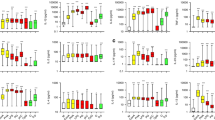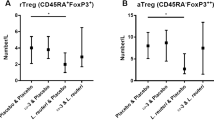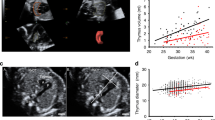Abstract
Background:
The maternal inflammation status during pregnancy has been associated with metabolic imprinting and obesity development in the child. However, the influence of the maternal Th2 cytokines, interleukin-4 (IL4), IL5 and IL13, has not been studied so far.
Methods:
We investigated the relationship between maternal innate (IL6, IL8, IL10 and tumor necrosis factor-α (TNFa)) and adaptive (interferon-γ, IL4, IL5 and IL13) blood cytokine levels at 34 weeks of gestation and children’s overweight development until the age of 3 years in 407 children of the German longitudinal LINA (Lifestyle and Environmental Factors and their Influence on Newborns Allergy risk) cohort. Children’s body weight and height were measured during the annual clinical visits or acquired from questionnaires. Body mass index (BMI) Z-scores were calculated according to the WHO reference data to adjust for child’s age and gender. Cytokine secretion was stimulated with phytohemagglutinin or lipopolysaccharide and measured by cytometric bead assay. Furthermore, we assessed metabolic parameter in blood of 318 children at age 1 using the AbsoluteIDQ p180 Kit (Biocrates LIFE Science AG).
Results:
Applying logistic regression models, we found that an increase of maternal IL4 and IL13 was associated with a decreased risk for overweight development in 1- and 2-year-old children. This effect was consistent up to the age of 3 years for IL13 and mainly concerns children without maternal history of atopy. Children’s acylcarnitine concentrations at 1 year were positively correlated with maternal IL13 levels and inversely associated with the BMI Z-score at age 1.
Conclusions:
We were able to show for the first time that the maternal Th2 status may be linked inversely to early childhood overweight development accompanied by an altered metabolic profile of the fetus. However, our data do not support a direct mediating role of acylcarnitines on maternal IL13-induced weight development.
This is a preview of subscription content, access via your institution
Access options
Subscribe to this journal
Receive 12 print issues and online access
$259.00 per year
only $21.58 per issue
Buy this article
- Purchase on Springer Link
- Instant access to full article PDF
Prices may be subject to local taxes which are calculated during checkout


Similar content being viewed by others
References
Herberth G, Hinz D, Roder S, Schlink U, Sack U, Diez U et al. Maternal immune status in pregnancy is related to offspring's immune responses and atopy risk. Allergy 2011; 66: 1065–1074.
Ingvorsen C, Brix S, Ozanne SE, Hellgren LI . The effect of maternal Inflammation on foetal programming of metabolic disease. Acta Physiol 2015; 214: 440–449.
Weisse K, Winkler S, Hirche F, Herberth G, Hinz D, Bauer M et al. Maternal and newborn vitamin D status and its impact on food allergy development in the German LINA cohort study. Allergy 2013; 68: 220–228.
Lecoutre S, Breton C . Maternal nutritional manipulations program adipose tissue dysfunction in offspring. Front Physiol 2015; 6: 158.
Palmer AC . Nutritionally mediated programming of the developing immune system. Adv Nutr 2011; 2: 377–395.
Daneva AM, Hadzi-Lega M, Stefanovic M . Correlation of the system of cytokines in moderate and severe preeclampsia. Clin Exp Obstet Gynecol 2016; 43: 220–224.
Dahlgren J, Nilsson C, Jennische E, Ho HP, Eriksson E, Niklasson A et al. Prenatal cytokine exposure results in obesity and gender-specific programming. Am J Physiol Endocrinol Metab 2001; 281: E326–E334.
Danielsen I, Granstrom C, Rytter D, Halldorsson TI, Bech BH, Henriksen TB et al. Subclinical inflammation during third trimester of pregnancy was not associated with markers of the metabolic syndrome in young adult offspring. Obesity 2014; 22: 1351–1358.
Tsao CH, Shiau MY, Chuang PH, Chang YH, Hwang J . Interleukin-4 regulates lipid metabolism by inhibiting adipogenesis and promoting lipolysis. J Lipid Res 2014; 55: 385–397.
Kang K, Reilly SM, Karabacak V, Gangl MR, Fitzgerald K, Hatano B et al. Adipocyte-derived Th2 cytokines and myeloid PPARdelta regulate macrophage polarization and insulin sensitivity. Cell Metab 2008; 7: 485–495.
Kwon H, Laurent S, Tang Y, Zong H, Vemulapalli P, Pessin JE . Adipocyte-specific IKKbeta signaling suppresses adipose tissue inflammation through an IL-13-dependent paracrine feedback pathway. Cell Rep 2014; 9: 1574–1583.
Millington DS, Kodo N, Norwood DL, Roe CR . Tandem mass spectrometry: a new method for acylcarnitine profiling with potential for neonatal screening for inborn errors of metabolism. J Inherit Metab Dis 1990; 13: 321–324.
Oberbach A, Bluher M, Wirth H, Till H, Kovacs P, Kullnick Y et al. Combined proteomic and metabolomic profiling of serum reveals association of the complement system with obesity and identifies novel markers of body fat mass changes. J Proteome Res 2011; 10: 4769–4788.
Kim JY, Park JY, Kim OY, Ham BM, Kim HJ, Kwon DY et al. Metabolic profiling of plasma in overweight/obese and lean men using ultra performance liquid chromatography and Q-TOF mass spectrometry (UPLC-Q-TOF MS). J Proteome Res 2010; 9: 4368–4375.
Cho K, Moon JS, Kang JH, Jang HB, Lee HJ, Park SI et al. Combined untargeted and targeted metabolomic profiling reveals urinary biomarkers for discriminating obese from normal-weight adolescents. Pediatr Obes 2016; 12: 93–101.
Mihalik SJ, Michaliszyn SF, De Las Heras J, Bacha F, Lee S, Chace DH et al. Metabolomic profiling of fatty acid and amino acid metabolism in youth with obesity and type 2 diabetes. Diabetes Care 2012; 35: 605–611.
Wahl S, Yu Z, Kleber M, Singmann P, Holzapfel C, He Y et al. Childhood obesity is associated with changes in the serum metabolite profile. Obesity Facts 2012; 5: 660–670.
Butte NF, Liu Y, Zakeri IF, Mohney RP, Mehta N, Voruganti VS et al. Global metabolomic profiling targeting childhood obesity in the Hispanic population. Am J Clin Nutr 2015; 102: 256–267.
Herberth G, Bauer M, Gasch M, Hinz D, Roder S, Olek S et al. Maternal and cord blood miR-223 expression associates with prenatal tobacco smoke exposure and low regulatory T-cell numbers. J Allergy Clin Immunol 2014; 133: 543–550.
Kuhn T, Floegel A, Sookthai D, Johnson T, Rolle-Kampczyk U, Otto W et al. Higher plasma levels of lysophosphatidylcholine 18:0 are related to a lower risk of common cancers in a prospective metabolomics study. BMC Med 2016; 14: 13.
Hayes AF . <Hayes Chapter 1pdf> Introduction to Mediation, Moderation, and Conditional Process Analysis: A Regression-Based Approach. Guilford Publications: New York, NY, USA, 2013.
Junge KM, Bauer T, Geissler S, Hirche F, Thurmann L, Bauer M et al. Increased vitamin D levels at birth and in early infancy increase offspring allergy risk-evidence for involvement of epigenetic mechanisms. J Allergy Clin Immunol 2016; 137: 610–613.
Junge KM, Hornig F, Herberth G, Roder S, Kohajda T, Rolle-Kampczyk U et al. The LINA cohort: cord blood eosinophil/basophil progenitors predict respiratory outcomes in early infancy. Clin Immunol 2014; 152: 68–76.
Woo Baidal JA, Locks LM, Cheng ER, Blake-Lamb TL, Perkins ME, Taveras EM . Risk factors for childhood obesity in the first 1,000 days: a systematic review. Am J Prev Med 2016; 50: 761–779.
Hinz D, Bauer M, Roder S, Olek S, Huehn J, Sack U et al. Cord blood Tregs with stable FOXP3 expression are influenced by prenatal environment and associated with atopic dermatitis at the age of one year. Allergy 2012; 67: 380–389.
Lim RH, Kobzik L . Transplacental passage of interleukins 4 and 13? PLoS ONE 2009; 4: e4660.
Henriques CU, Rice GE, Wong MH, Bendtzen K . Immunolocalisation of interleukin-4 and interleukin-4 receptor in placenta and fetal membranes in association with pre-term labour and pre-eclampsia. Gynecol Obstet Invest 1998; 46: 172–177.
Girard S, Tremblay L, Lepage M, Sebire G . IL-1 receptor antagonist protects against placental and neurodevelopmental defects induced by maternal inflammation. J Immunol 2010; 184: 3997–4005.
Adams SH, Hoppel CL, Lok KH, Zhao L, Wong SW, Minkler PE et al. Plasma acylcarnitine profiles suggest incomplete long-chain fatty acid beta-oxidation and altered tricarboxylic acid cycle activity in type 2 diabetic African-American women. J Nutr 2009; 139: 1073–1081.
Mihalik SJ, Goodpaster BH, Kelley DE, Chace DH, Vockley J, Toledo FG et al. Increased levels of plasma acylcarnitines in obesity and type 2 diabetes and identification of a marker of glucolipotoxicity. Obesity 2010; 18: 1695–1700.
Acknowledgements
We thank all LINA families for participation in the study, Anne Hain and Gabriele Heimpold for technical support, and Melanie Nowak for her excellent study organization assistance. The LINA study was financed via Helmholtz institutional funding (Helmholtz Centre for Environmental Research—UFZ). Martin von Bergen and Ulrike Rolle-Kampczyk were partially supported by funding from SFB 1052.
Author information
Authors and Affiliations
Corresponding author
Ethics declarations
Competing interests
The authors declare no conflict of interest.
Additional information
Supplementary Information accompanies this paper on International Journal of Obesity website
Supplementary information
Rights and permissions
About this article
Cite this article
Englich, B., Herberth, G., Rolle-Kampczyk, U. et al. Maternal cytokine status may prime the metabolic profile and increase risk of obesity in children. Int J Obes 41, 1440–1446 (2017). https://doi.org/10.1038/ijo.2017.113
Received:
Revised:
Accepted:
Published:
Issue Date:
DOI: https://doi.org/10.1038/ijo.2017.113
This article is cited by
-
Longitudinal plasma inflammatory proteome profiling during pregnancy in the Born into Life study
Scientific Reports (2020)
-
Mild maternal sleep-disordered breathing during pregnancy and offspring growth and adiposity in the first 3 years of life
Scientific Reports (2020)
-
Developmental Programming of Body Composition: Update on Evidence and Mechanisms
Current Diabetes Reports (2019)



